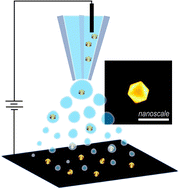Electrospray deposition for single nanoparticle studies†
Abstract
Single entity electrochemical (SEE) studies that can probe activities and heterogeneity in activities at nanoscale require samples that contain single and isolated particles. Single, isolated nanoparticles are achieved here with electrospray deposition of colloidal nanoparticle solutions, with simple instrumentation. Role of three electrospray (ES) parameters, viz. spray distance (emitter tip-to-substrate distance), ES current and emitter tip diameter, in the ES deposition of single Au nano-octahedra (Au ODs) is examined. The ES deposition of single, isolated Au ODs are analyzed in terms of percentage of single NPs and local surface density of deposition. The local surface density of ES deposition of single Au ODs was found to increase with decrease in spray distance and emitter tip diameter, and increase in ES current. While the percentage of single particle ES deposition increased with increase in spray distance and decrease in emitter tip size. No significant change in the single Au ODs ES deposition percentage was observed with change in ES current values included in this study. The most favourable conditions in the ES deposition of Au ODs in this study resulted in the local surface density of 0.26 ± 0.05 single particles per μm2 and observation of 96.3% single Au OD deposition.



 Please wait while we load your content...
Please wait while we load your content...
